The Many Cats of Mariquita
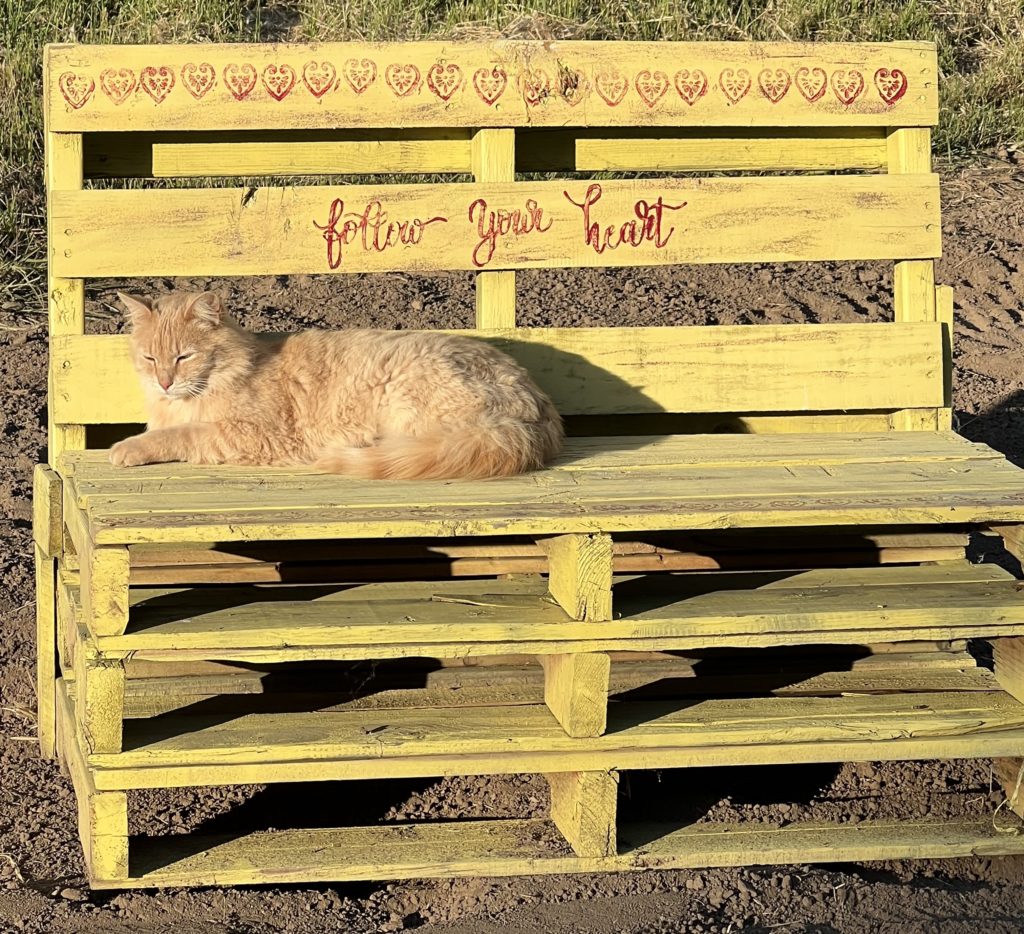
Samson watching over the Mariquita labyrinth
Oh, my God, the violence lay hidden in their hearts! One little old lady said she kept a loaded rifle by her sliding glass door so that if she saw one she could open the door… and open fire. Another woman said she connected a garden hose from the exhaust pipe of her husband’s Cadillac so that she could gas them to death.
I’d been invited to speak to a local Watsonville ladies’ garden club about the principles of organic agriculture but it turned out they were more interested in murdering gophers than they were in hearing about cover crops, beneficial insects, or mulches. “How do you fight gophers?” they asked me. So I told them about my black cat. That was years ago, and since that time, that cat and several others have come and gone from the farm, but I’ve loved and appreciated all of them. Here are their stories:
I was still working on Star Route Farm in Bolinas in 1983 when my first cat came to me. Two Israeli women were working on the farm at the time, Estee and Mirav. They’d been front line nurses in the Israeli Army during the Lebanon War, and when their tour of duty was finished, they came to the San Francisco Bay Area to unwind and recuperate their spirits by working on an organic farm and playing at being hippies. Estee and Mirav missed the Summer of Love by 16 years, but they enjoyed the tranquility that Bolinas had to offer, and since they’d grown up on an agricultural kibbutz they had lots of prior farming experience. After work they liked to take a stroll around the farm, and one summer evening they passed by the trailer where I was staying. I greeted them, and Mirav had a question for me.
“You have a pot?” she asked.
Mirav and Estee spoke Hebrew amongst themselves, and they were fluent in French, but their command of English was still charmingly erratic. “You want to borrow a pot?” I replied.
“No, no, what you say?” Mirav asked. “You have a little pot?”
“You want to buy pot?” I asked.
“No, no, no,” Mirav laughed. “You have a little pot friend?”
“A pet friend? I asked.
“Yes, yes, a pot friend!”
I told them that maybe I did. I’d noticed that somebody had come in through my trailer window when I was gone and licked the corners off a cube of butter that I’d had on the counter. So I put out a dish of cat food on the floor and left the window open, and soon I had a friendly black cat sharing my trailer- and hunting for gophers on the farm. Obviously, his name was “Pot Friend.”
I was surprised a few weeks later to hear a horse snorting outside my trailer, and when I opened the door, a nude woman riding bareback confronted me. “You stole my cat,” she said.
“No, I didn’t!” I said. “A black cat showed up here and I fed it.” Pot Friend came down the trailer steps and passed us by, paying her no mind. But he stayed with me, even when I moved to Santa Barbara to work on Winchester Canyon Ranch, and then again when I moved up to Watsonville and worked on Riverside Farms. Pot Friend’s black coat was salted with white by the time my kids were born and I was farming with Julia, but he was Mariquita Farm’s first official Farm Cat.
Our second cat, Taco, came to me by virtue of a tragic accident. A fellow who worked for us had a brother who was killed in a drunk driving accident. The whole family picked up and left with the body for Mexico, and on their way out they dropped a litter of kittens off at a farm field we were leasing. The kittens were tiny, and terrified. They hid under a pallet of cartons and survived by licking the grease off the tin foil the farm workers had wrapped their tacos in. I caught one little kitten and brought it home. He was a lovely, long-haired cat with Siamese “points” and I named him “Taco.” Taco survived and eventually thrived. He became Pot Friend’s gopher hunting companion and was the first cat my kids can really remember.
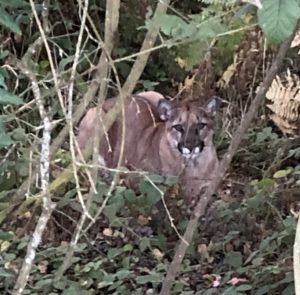
A mountain lion spotted on the farm
Sarah and Clara came next after a neighbor’s cat had a large batch of kittens. Sarah and Clara were more pets at first than “farm cats” and they played with the kids. I think pets are important for kids because they can teach a child how to express love and kindness. And, until “The lion lies down with the lamb,” it must be noted with sadness that pets can teach a young person how to deal with loss. Besides our “official farm cats” we also have our fair share of predatory wild cats, like Bobcats and Mountain lions. Yes, we have lots of coyotes too, and since they make so much noise they end up taking the blame for most disappearances, but I’m convinced that the Bobcats are often the culprits; it’s just that they come and go with such stealth. Sarah and Clara did grow up to be hunters, but we lost Clara.
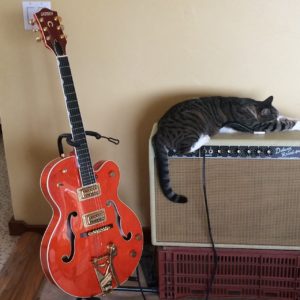
Sarah, the Rockabilly Hep Cat, lounging
Sarah lost a leg to cancer, and she became a full-time house cat. Sarah liked to sleep on my Fender amplifier when I played my electric guitar, and since I play an orange Gretsch 6120, like Duane Eddy and Poison Ivy, I called Sarah my “Rockabilly Hep Cat.”
After Sarah passed away Starr and I adopted two kittens from the local shelter and she named them “Samson & Deliah,” after the Reverend Gary Davis song that was popularized by the Grateful Dead. Samson is still with us, and he’s as beautiful and lordly as an apricot blonde male cat born under the sign of Leo can be. But Delilah tended to wander into the forest where the wild things are, and one day she didn’t come back. We felt sad that Samson didn’t have company so we kept our ears open for kittens. When our friends, Todd and Jordan, who have Happy Girl Kitchen in Pacific Grove and who put our farm’s produce in jars for us, bought a place in upper Carmel Valley, we were gifted two matching tabby kitten twins. The rural property that they purchased had an unruly tribe of feral cats on it, so they set about catching them and spaying and neutering them and finding homes for the kittens.
The two kittens showed up early in the whole Covid drama, and they very much lightened the mood for us. They were small and wild, but proved to be very sweet and tameable. We initially named them “Cachagua & Tassajara” after landmarks in the neighborhood they came from, but Starr shortened the names to “Casha and Tassa.” The sisters are not quite identical, but they can be hard to tell apart from a distance, so they are often known as “This and That,” as in “this cat” versus “that cat.” This and That have turned into good hunters, and they’re helping Samson to keep the ever-present population of gophers in check.
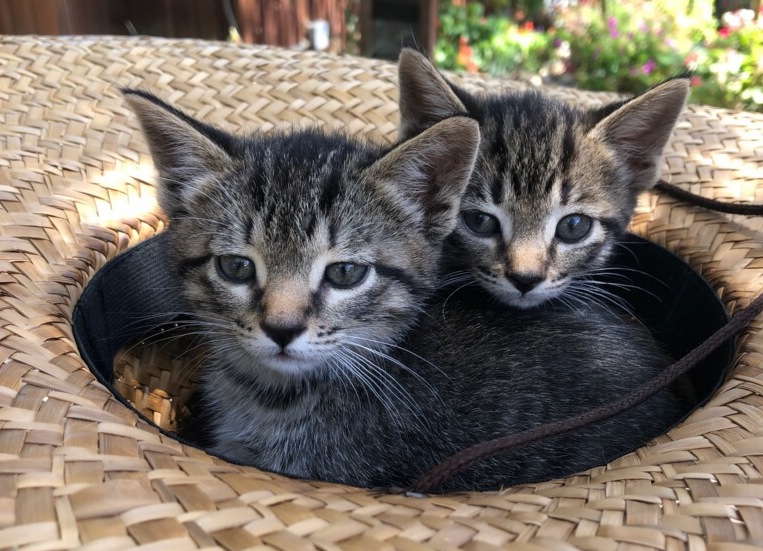
Casha and Tassa as kittens
Because we love our cats and appreciate their efforts, we have planted plenty of catnip around the farm so that they can pepper all their hard farm labor with moments of euphoria. Catnip is in the mint family, but it tolerates relatively dry conditions. We have it planted on a sunny slope and it’s thriving. Catnip is one of those plants that could become a weed if we let it, but we clip it and dry it before it goes to flower. Catnip dries well and remains pungent. It’s spring now, and the plants are growing fast so Starr has been keeping the dehydrators working around the clock.
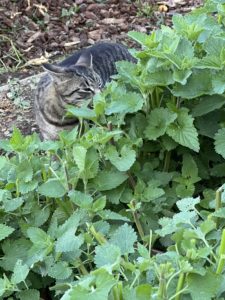
Tassa taking in the catnip
If you want to treat your cat to a whiff of locally grown, aromatic, organic catnip, now is the time to get it. Or maybe you want some for yourself. Catnip is usually thought of as a cat herb, but people do make aromatic herbal infusions from it that are reputed to be good for treating colds, fevers and flues, and dried catnip is used as a seasoning in some cuisines. I offer it to my restaurant customers and I’ve noticed that the places that focus on Italian food buy it. I need to ask them how they’re using it. Catnip, or Nepeta cataria, has a scent that is not unlike its cousin Nepitella, or Calaminta nepeta, also known as “Roman mint.”
Tassa likes to hang out when we garden. She is Mariquita Farm’s “spokes cat” and social media influencer. She enjoys and endorses our catnip products and personally oversees the harvests. Check out the shop store, we are harvesting today!
© 2022 Essay by Andy Griffin
Photos by Andy Griffin and Starr Linden


